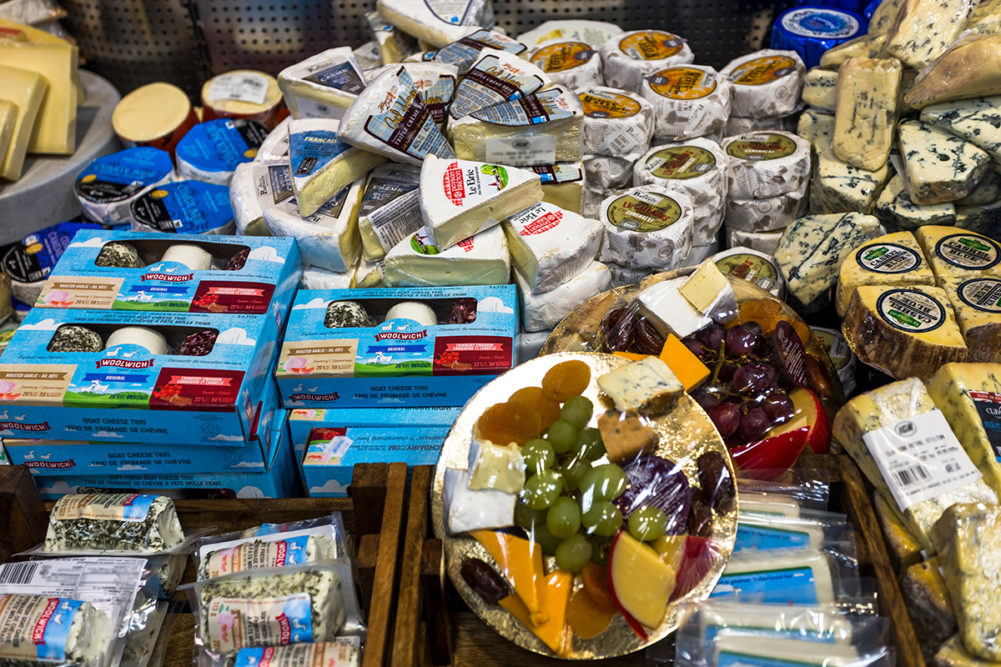For cheese merchants, getting customers to leave the shop with more than just cheese can mean the difference between red ink and black. A pint of olives, some premium crackers, a slice of quince paste to go with Manchego—these are the add-on purchases, often impulse buys, that can result from clever cross-merchandising. If you’d like to do a better job of cross-merchandising with cheese, follow these 10 top tips.
1. Know your products and be passionate about them
Excitement is contagious. “I do a lot of talking, says Nancy Ford, manager of the 24th Street Cheese Company in San Francisco. “And I don’t talk people into anything that I don’t think is good. So when I’m psyched up about something, customers want to try it.” Recently, Ford brought in a new line of French condiments for cheese and sold a case in a week because customers sensed her excitement.
2. Consider adjacencies: what’s next to what
Position products to fit shoppers’ purchasing patterns. From cheese to olives to charcuterie to bread might be one such logical sequence. Many retailers put olives next to the cheese case, or even in the cheese case, because olives are such a natural add-on.
3. Make it take-able
Put the complementary item where people can easily grab it. If you are recommending aged Balsamic vinegar with Parmigiano-Reggiano, put the vinegar within reach. Very few people will make an effort to track something down.
4. Offer unique items
Make your store the place to come for condiments that shoppers cannot find in the supermarket. Star Provisions in Atlanta makes its own olive mix, a blend of eight or nine varieties with extra virgin olive oil, herbes de Provence and crushed red pepper. The Village Cheese Shop in Southampton, N.Y., makes herbed toasts from day-old bread and packages them as crostate, seasoned crisps that complement many creamy cheeses.
5. Tell a story
Ihsan Gurdal, proprietor of Formaggio Kitchen in Cambridge and Boston, travels frequently to Europe to source cheeses and condiments and to experience traditional pairings firsthand. Recently, Gurdal began importing farmhouse preserves from France’s Ardèche and Basque regions, condiments typically served with the cheeses from those areas. He learned that the Basques serve black cherry preserves spiked with eau de vie to complement the strong local sheep’s milk cheeses made at high altitudes; with milder cheeses from the valley, they serve the preserves au naturel.
6. Excite your staff
Give them opportunities to taste and learn. Encourage them to develop opinions about good partners for cheese and to share those opinions with customers. Train your counter people to suggest accompaniments. At the Cheese Shop of Virginia, employees routinely ask, “Would you like a loaf of freshly baked bread or crackers with that?”
7. Have an active sampling program
If customers taste it, they will purchase it, retailers say. Adam Batcheller of the Village Cheese Shop says he recently offered samples of burrata, a fresh southern Italian cheese similar to mozzarella, drizzled with French olive oil, and customers bought both cheese and oil.
At Joan’s on Third, a specialty food store and deli in Los Angeles, mostarda (Italian preserved fruits with mustard oil) was a slow seller until the staff began offering tastes of it with Parmigiano-Reggiano.
8. Cross-merchandise with items from your kitchen or deli
In the cheese case, that could mean a house-made chutney or tapenade. If your store makes sandwiches, highlight the cheese. Offer ham and Emmenthal rather than ham and Swiss or, as the Village Cheese Shop does, an English farmhouse cheddar and bacon sandwich.
9. Don’t hard sell
Customers like suggestions, but they will balk if they feel you are aggressively trying to build the sale. If your attitude is ‘sell, sell,’ customers sense it. Instead, the attitude should be ‘learn, learn,’ then ‘teach, teach.’ And when you’re talking to one customer, three others are listening.
10. Plan your cross-merchandising
Make it part of your merchandising schedule for the year. Beefing up a display for cross-merchandising can mean a lot of extra work for employees, but if they know in March about the Spanish promotion in June, they have time to get involved and motivated.
This article is an excerpt from the October 2023 issue of Supermarket Perimeter. You can read the entire Cheese Merchandising feature and more in the digital edition here.

